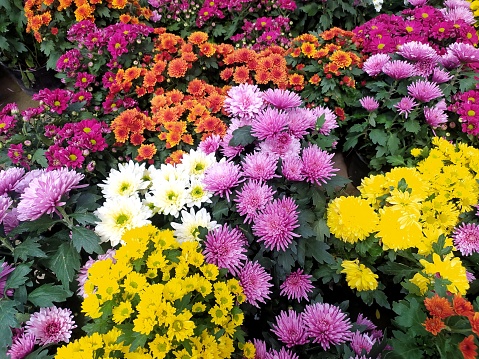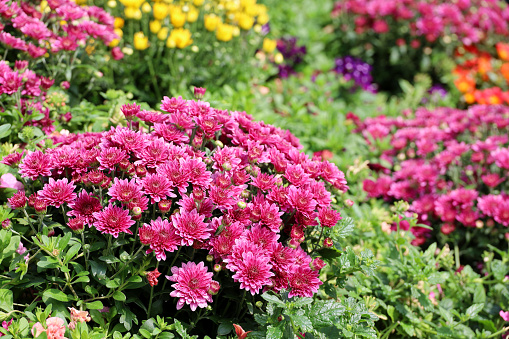‘This the time for Chrysanthemums to shine! After all, these colourful and vibrant beauties are the November birth flower. Chrysanthemums, popularly known as ‘Mums’, are those lovely blooms that have captivated hearts across cultures and generations, carrying immense symbolism and significance. In this blog, we explore the meaning of chrysanthemums, shedding light on the magic they bring to various occasions and celebrations.
Chrysanthemum Meanings

Source: Pixabay
Chrysanthemums, scientifically known as Chrysanthemum Indicum, belong to the family of Asteraceae. They symbolise a multitude of meanings across different cultures, majorly representing joy, happiness and longevity in different parts of the world. Besides, its gorgeous hues convey positivity and optimism.
In Chinese culture, chrysanthemums are associated with life and rebirth, making them a suitable choice for funerals. In Japan, these blooms are a symbol of the Emperor and the imperial family, signifying honour and nobility. These flowers also carry various meanings in different countries, adding to their versatile symbolism.
Chrysanthemums in Celebrations

Source: Pixabay
The chrysanthemum plant plays a significant role in various celebrations and events worldwide. In China, these blooms take the spotlight during the Double Ninth Festival; Tết Trùng Cửu (chữ Hán: 節重九), where they represent strong yang energy and are believed to bring protection and ward off evil spirits.
On the other hand, in Japan, the Chrysanthemum Throne is a symbol of the emperor’s authority and these flowers are used in the annual Chrysanthemum Festival, showcasing breathtaking floral arrangements.
In the West, chrysanthemums are popular choices for Mother’s Day bouquets, symbolising love and gratitude.
Chrysanthemum Symbolism & Colours

Source: Pixabay
Chrysanthemums boast a rich tapestry of symbolism, with each colour carrying unique meanings –
- The vibrant yellows signify happiness, joy and positivity, making them popular choices for celebrating happy occasions. However, in some cultures, yellow mums also symbolise neglected love or sorrow. Choose them wisely!
- White chrysanthemums embody purity, innocence, and truth, often seen in weddings and religious ceremonies.
- Red chrysanthemums symbolise love and deep passion, making them ideal for expressing romantic feelings.
- Next are pink chrysanthemums that represent friendship and affection. In fact, they hold a special place in Japan since they represent the Imperial family.
- Orange chrysanthemum symbolism falls a bit in between that of red and yellow flowers. They are linked with excitement, happiness, and other good feelings.
- If you are lucky, you will come across violet chrysanthemums! They are highly gorgeous that are a little challenging to find. These purple blooms symbolise thoughtfulness and care.
Chrysanthemum Facts

Source: Pixabay
If you think Chrysanthemums follow a one-size-fits-all approach, you could not be more wrong!
- These flowering plants come in various shapes and sizes, ranging from dainty daisies to large, pompom-like blooms.
- These hardy perennials are native to Asia and northeastern Europe.
- Chrysanthemums are not only celebrated for their beauty but also for their medicinal properties. They contain natural insect-repellent qualities, making them useful in gardens to ward off pests.
- Furthermore, chrysanthemum tea, brewed from dried flowers, is popular in many cultures for its health benefits, believed to aid in relaxation and improve overall well-being.
- Chrysanthemums have also found their way into art and literature, serving as muses to countless artists and writers. Renowned painters like Claude Monet and Vincent van Gogh featured chrysanthemums in their masterpieces, capturing the elegance and allure of these blooms.
- In literature, chrysanthemums have their presence in poems, stories and even haikus that reflect the deep admiration humanity holds for these exquisite flowers.
Chrysanthemum Uses

Source: Pixabay
Chrysanthemums find diverse applications beyond their decorative purposes.
- In traditional medicine, chrysanthemum extracts are used for their anti-inflammatory and antioxidant properties, promoting health and vitality.
- Their petals are often utilised in culinary creations, adding a subtle, floral flavour to teas, salads, and desserts.
- Chrysanthemums also serve as natural dyes, infusing fabrics with vibrant hues.
- Their pleasant fragrance also makes them a popular choice for perfumes and scented products.
Given the aforementioned information, it’s evident that these blooms are not just visually appealing but also carry deep cultural significance. So, the next time you encounter these lovely blooms or gift them as a flower bouquet, be mindful of the stories they tell and the emotions they convey.






